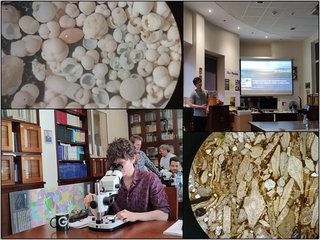Since its first edition in 2006, the International School on Foraminifera (ISF) has been dedicated to training graduate students and industry professionals who seek to deepen their knowledge of Foraminifera, Micropalaeontology, Paleoceanography, Paleoecology, and Climate History. The 15th edition of the ISF, entitled “Advanced Course on Foraminiferal Biostratigraphy” (June 9-20, 2024), was organized by Micropress Europe and took place at the AGH University of Science & Technology in Kraków, Poland. This edition focused on advanced, specialized training in foraminiferal biostratigraphy while also providing a comprehensive overview of the taxonomy and geological history of both benthic and planktonic foraminifera.
This intensive course comprised 40 hours of lectures and 40 hours of practical work, featuring contributions from eight lecturers and participation from fourteen attendees. The lectures, given by some of the world’s leading experts in their fields, covered topics such as foraminiferal classification schemes, recovery methods, evolution and life history, stratigraphic distribution, biostratigraphy, paleoenvironment, and industrial applications. These subjects were explored in detail for the different groups of foraminifera (small benthic, large benthic, and planktonic) and from key geological intervals, ranging from the Carboniferous to the Quaternary.
The practical sessions focused primarily on the taxonomic identification of various foraminiferal groups. During microscope lab sessions, participants examined thin sections and sediment residue samples from different geological periods, collected from ODP sites and petroleum exploration areas. Additionally, the knowledge gained from the lectures was reinforced through practical exercises of foraminiferal applications, such as biostratigraphic zonal schemes, correlation, and paleoenvironmental interpretations of well sites.
Throughout the course, participants also had the opportunity to present their work to the lecturers and fellow attendees, providing an environment of positive discussions and feedback on everyone’s research. This also provided opportunities for friendly networking, potentially leading to future scientific collaborations.
I am grateful to the GSGS for supporting my attendance at the 15th ISF. The theoretical and practical knowledge I gained during this course will be fundamental to the success of my Ph.D. thesis and my career as a micropaleontologist, which focus on foraminiferal taxonomy, biostratigraphy, and paleoenvironment. I also thank Micropress Europe for organizing this amazing summer school, which I highly recommend to any researcher looking to specialize in the study of fossil foraminifera and their applications.
Tiago Menezes Freire
PhD student
Institute of Geology and Mineralogy
PhD project: “Surface variability of the Eastern Boundary Current off Chile during the Early and Middle Miocene”
